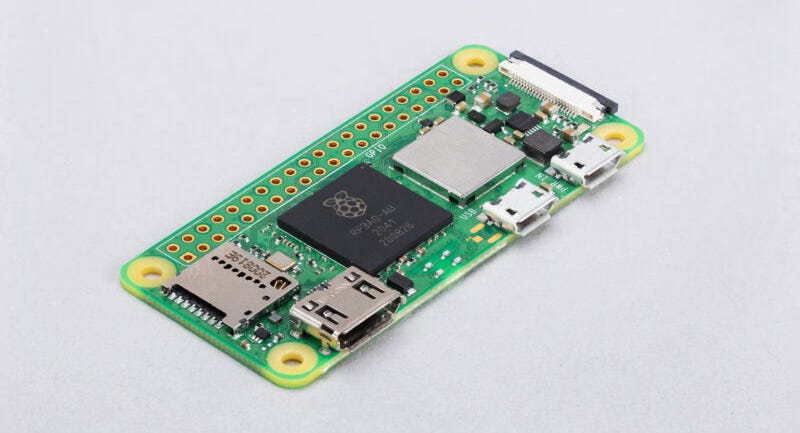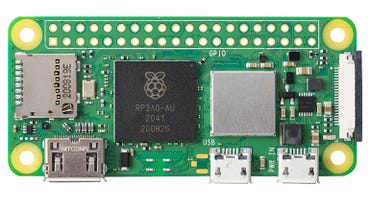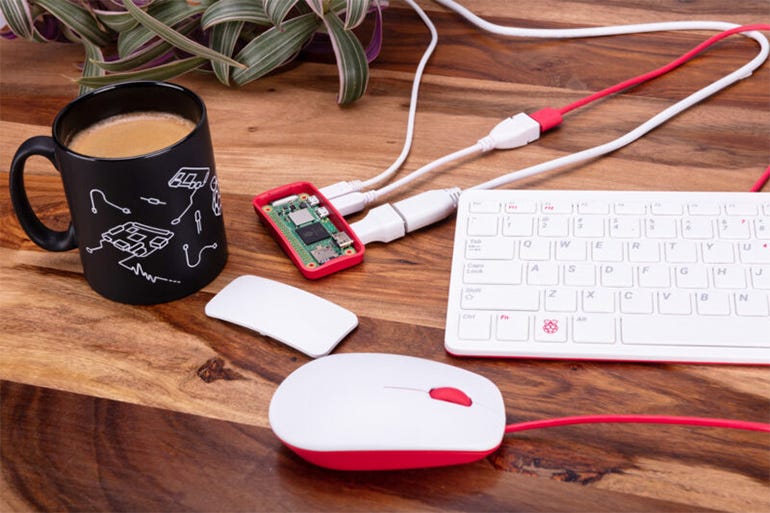When Will Pi Zero Be Available Again 2017

The Raspberry Pi Zero 2 W has the same form factor as previous models, but adds a quad-core RP3A0 SoC.
Image: Raspberry PiThe Raspberry Pi Zero has been effectually for six years now, originally launching in November 2022 as a USB-only device for $5. Over the years the form factor has evolved, adding wireless for $10 in 2017, and pre-soldered headers in 2018. Just one thing didn't alter over those years: the processor. That remained the familiar BCM2835 that launched the original Raspberry Pi dorsum in 2012.
Nearly a decade of life is expert for a processor, simply as workloads evolve and projects built on the Pi go more and more circuitous, it was starting to show its age. I recently attempted to use a Pi Zilch WH to drive a 4-inch touch screen for a simple monitoring project, and quickly swapped it out for a Raspberry Pi 4. At the same time, supplies of the Pi Zero started to dry up, faster than expected with the electric current chip dearth. Was a new Pi Zippo on the horizon?
It was.

Like
- Small-scale and fast
- Runs nearly existing Pi software
- Drop-in replacement for older Pi Zippo hardware
Don't Similar
- Only 512MB of RAM
- GPIO header needs to be soldered on
- Limited availability in 2022 due to fleck shortages
A new Raspberry Pi silicon package
The launch of the $15 Pi Zero 2 W was still something of a surprise. Not only did information technology offer considerable speed upgrades, information technology introduced new Raspberry Pi-specific silicon packaging in the RP3A0. Starting with the same quad-cadre 64-bit ARM Cortex-A53 SoC used in the Raspberry Pi 3 (BCM2710A1), it packages the processor die with 512MB of SDRAM, putting the retentivity in the same package as the SoC. The packaging even includes its ain copper heatsinks, which should hateful the Pi Nix 2 W runs libation than its predecessor -- even when it'south running at 1 GHz. This isn't Raspberry Pi developing its ain silicon similar it did with the RP2040, only it is providing its own spin on silicon packaging.
While it might accept seemed logical for the Raspberry Pi team to continue adding capabilities to its core unmarried-board computer family, bringing out a smaller, lower-cost version of technologies information technology's shipped in the past really makes a lot of sense. Non everyone needs the power of the Raspberry Pi iv, and the Pi Zero 2 Due west lets you lot take everything you've learned and use information technology to create smaller versions of existing builds, or undertake hardware projects you've postponed for desire of a compute module that'due south pocket-size enough.
That's some other benefit of the Pi Null 2 Due west. It's been certified as a wireless module in its own right, and then it can exist dropped into hardware without needing new certifications. Going from prototype to production has ever been hard, but if you can make your prototype office of your product, you can salvage a lot of time. Edifice on the Pi platform too gives you the adequacy to update both software and Bone wirelessly.
Comparison the one-time and the new
Put the Pi Zero ii adjacent to a Pi Zero and y'all'll see very few differences. It's still the same 65mm x 30mm board, with the same mounting holes. The new RP3A0 chip dominates the board, aslope a large, shielded expanse that contains all the wireless circuitry. You go the same pair of Micro-USB ports, 1 for power and one for OTG-based I/O, along with a Mini-HDMI port. Everything is in the same place, so yous should exist able to drop the new lath in as a replacement for any older Pi Zeros. At that place might be a slight issue with the HDMI port, as the socket is slightly larger, and so if you have 3D-printed a custom example you may need to make some changes to your design.
Other ports include the Raspberry Pi's standard camera port and a pin-out for the Pi GPIO ports. Currently the Pi Zippo 2 doesn't come up with a set of header pins, like the Pi Zero WH. This means soldering your own. This shouldn't be too hard, but I'd recommend practicing before raising a soldering atomic number 26 to your Pi! Calculation a header is essential if y'all plan to use the Pi Zero 2 W with any HATs.
Most Raspberry Pi vendors sell sets of connectors and adapters for the Pi Cypher, and it's well worth investing in one if y'all're using a Pi Zero 2 for evolution. You'll need a Micro-USB to USB-A converter, a Mini-HDMI to HDMI converter, and a set of GPIO header pins. If you're merely using a subset of pins for your projects, y'all have the selection of soldering connecting leads directly into the board.
Using the new Pi Nothing
I tested the Pi Zippo 2 W using a copy of the 32-bit release of Raspberry Pi OS. While the device SoC supports 64-bit ARM code, the 512MB of SDRAM can be a limitation. Using a 32-flake Os can help you squeeze more than out of its express retention, as the development team has indicated that there will exist no other memory options.
This is the kickoff Pi Zero that could be considered suitable for basic desktop operations. The built-in HDMI port works with nearly screens, although again available memory is a limitation. In practice you lot're more likely to use the device in headless mode, using either alternative display modules like east-newspaper or simply using SSH to connect to your Pi from a PC.
That last option was how I chose to use my device, configuring SSH and wireless connectivity while edifice a kick Micro-SD bill of fare. Once it had connected to my wireless network, I could log in using the default username and countersign combination, before updating the OS. If you're non familiar with Raspberry Pi Bone, information technology's a Debian-derived Linux, and uses the familiar apt tooling to manage packages. Other Bone options are bachelor, using the PC-based Raspberry Pi imaging tool to download images and load them onto Micro-SD cards.
SEE: What is quantum calculating? Everything you need to know virtually the strange earth of quantum computers
As yous'd wait, information technology's a Raspberry Pi. If you lot've used one before you should be familiar with the Raspberry Pi Bone basic installation, with its complement of evolution tools like Python. Functioning is good, although surprisingly the beta Arm7 version of the Geekbench benchmarking suite crashed while trying to examination the device.
Most of my current Python-based projects ran well, and I was able to use the Visual Studio Lawmaking remote extension to piece of work confronting it over a wireless connexion, installing the Lawmaking remote server and exploring the filesystem, as well as reading and writing files from my development PC. Where the original Pi Zero struggled to run the remote server, the new hardware had no bug at all.

The Pi Zero 2 W should drop in as a replacement for older Pi Zeros, although some custom 3D-printed cases may need adjustment to conform the larger HDMI socket.
Conclusions
It'due south probably best to compare the Pi Zero 2 W to the Raspberry Pi 3 Model A. Both have similar characteristics, and the same 512MB of SDRAM. Yes, the Pi Zero 2 W has fewer ports and no Ethernet, and is clocked slightly lower, but it would make a reasonable replacement device, taking up significantly less infinite. You can quickly port code across, and every bit both apply the same GPIO port layout (and the aforementioned HATs), hardware integration should be relatively easy.
Ane thing is clear: the Pi Zero 2 W doesn't supplant the Raspberry Pi Zero. Instead, it's best to recall of it as a third member of the Pi Null family at a new cost point. The original Pi Zero continues at $five, the Pi Zilch W at $10, and now we have the Pi Null two West at $15. It's going to be around a long time, too, with plans to keep it in production until at least early on 2028. If you demand a depression-cost, single-board device, it's well worth the investment.
RECENT AND RELATED CONTENT
Raspberry Pi Aught 2 W: New $fifteen board offers up to 5x the performance of its predecessor
New Raspberry Pi: Naught WH promises cheaper and easier homebrew hardware
Raspberry Pi Cipher W, hands-on: A very welcome new member of the family
Hands-On with the Raspberry Pi Cypher
Raspberry Pi makes its first always price increase, global chip shortage to blame
Read more reviews
- Microsoft Surface Duo 2 review in progress: 2 weeks in and I'chiliad as confused as I am intrigued
- Honor fifty review: Google Mobile Services put this 5G handset on the mid-range map
- XGIMI Aureola Ultra Short Throw Light amplification by stimulated emission of radiation Projector review: Perfect for businesses and the dwelling house theatre aficionados
- Apple 16-inch MacBook Pro (M1 Max, late 2021) review: Apple supercharges its flagship laptop
- iPhone 13, Google Pixel vi Pro, Fairphone 4 5G, Dell XPS 17 9710, and more: ZDNet'due south reviews roundup
Source: https://www.zdnet.com/article/raspberry-pi-zero-2-w-review-performance-in-a-small-form-factor/
0 Response to "When Will Pi Zero Be Available Again 2017"
Post a Comment